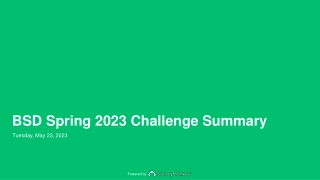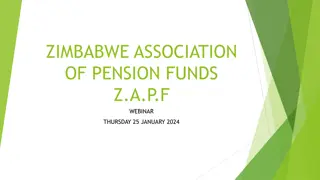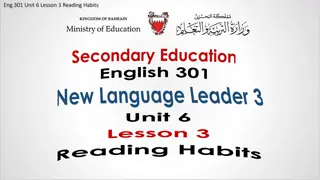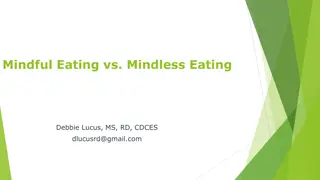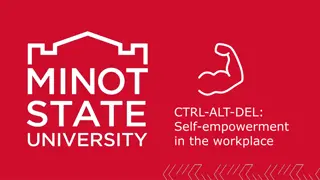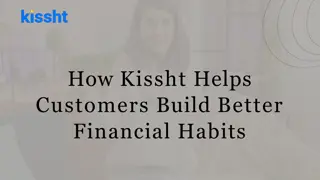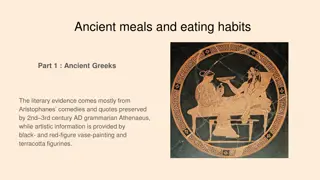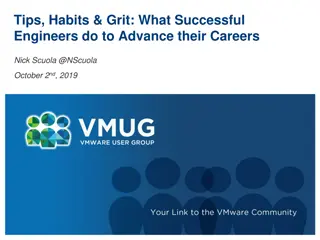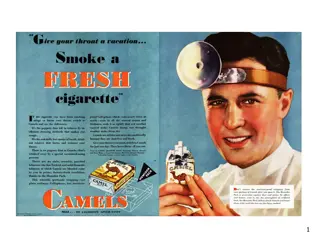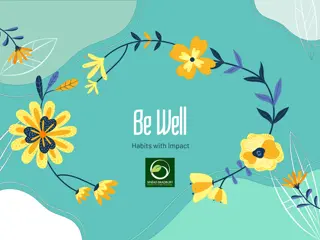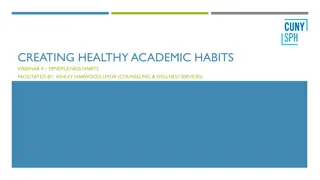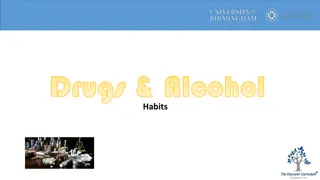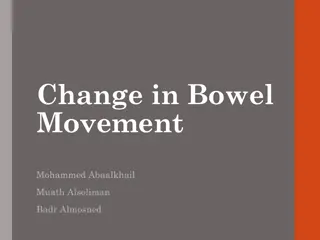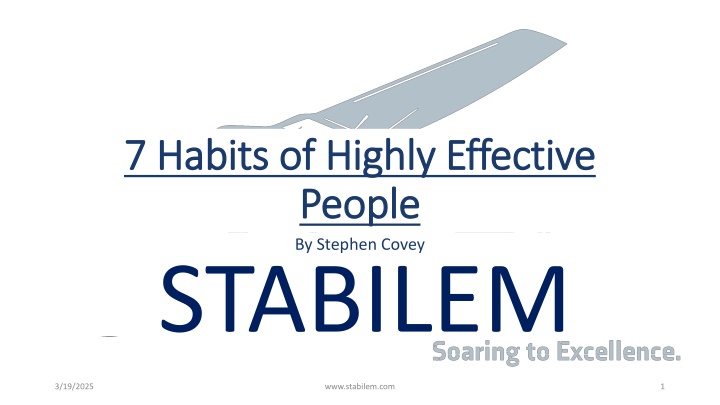
Effective Personal Development Strategies from Covey's 7 Habits
Discover key concepts such as developing habits, emotional intelligence, and P/PC balance for personal growth from renowned author Stephen Covey's book "7 Habits of Highly Effective People". Explore the importance of paradigms, avoiding potential traps, and understanding the difference between principles and values.
Uploaded on | 2 Views
Download Presentation

Please find below an Image/Link to download the presentation.
The content on the website is provided AS IS for your information and personal use only. It may not be sold, licensed, or shared on other websites without obtaining consent from the author. If you encounter any issues during the download, it is possible that the publisher has removed the file from their server.
You are allowed to download the files provided on this website for personal or commercial use, subject to the condition that they are used lawfully. All files are the property of their respective owners.
The content on the website is provided AS IS for your information and personal use only. It may not be sold, licensed, or shared on other websites without obtaining consent from the author.
E N D
Presentation Transcript
7 Habits of Highly Effective 7 Habits of Highly Effective People People By Stephen Covey STABILEM 3/19/2025 www.stabilem.com 1
4 Roles of Leadership 4 Roles of Leadership Increased Influence The 7 Habits Focus Here 3/19/2025 www.stabilem.com 2
Developing Habits Developing Habits A habit is defined as an intersection of knowledge, skill, and desire. Knowledge is understanding what to do and why to do it; skill is knowing how to do it; desire is motivation or wanting to do it. To make habits, we need to develop all three components. Knowledge Desire (want) (why?, what?) Habits Skill (how?) People don't decide their future. They decide their habits, and their habits decide their futures. - F.M. Alexander 3/19/2025 www.stabilem.com 3
Emotional Bank Account Emotional Bank Account The EBA is a metaphor for the trust that exists in a relationship. It suggests that every interaction with another person may be classified as a deposit or withdrawal. Deposits build and repair trust in relationships. Withdrawals lessen trust in relationships. 3/19/2025 www.stabilem.com 4
P/PC Balance P/PC Balance The production can be pieces of the assembly line, health, energy, happiness, etc. Production Capability can be associates, equipment, supplier relations, community relations, etc. The main idea is to take care of that which is producing what you need. 3/19/2025 www.stabilem.com 5
Paradigms Paradigms Paradigms can be compared to a roadmap. If your map is correct, you can get where you are going. If your map is incorrect, you are destined to get lost. Furthermore, if you have the wrong map and try to get where you are going faster, you get lost even faster. Examples: Battleship 3/19/2025 www.stabilem.com 6
Potential Traps Potential Traps Social Mirrors The way we see ourselves because others reflect their perceptions, opinions, and paradigms about us through their words and behaviors. Self-Fulfilling Prophecy Our beliefs about ourselves and others influence our self-perception, behavior, and performance. 3/19/2025 www.stabilem.com 7
Principles vs. Values Principles vs. Values Principles: Universal, timeless. Produce predictable outcomes. External to ourselves Operate with or without our understanding or acceptance. Self-Evident and enabling when understood. Values: Self-chosen beliefs or ideas Internal, subjective, based on how we see the world. Influenced by upbringing, society, and personal reflection. 3/19/2025 www.stabilem.com 8
Character vs. Personality Character vs. Personality Your appearance and the perception that you convey can bring you outward success. However, true effectiveness comes from a grounded character. You may put on a front, but your true character can be revealed under pressure. Personality Character 3/19/2025 www.stabilem.com 9
Effectiveness Effectiveness Effectiveness = Doing the Right Things Right; Getting what you want and getting it in a way that you can get it repeatedly. 3/19/2025 www.stabilem.com 10
Seven Habits Continuum Seven Habits Continuum You can t have Public Victory without first having Private Victory. 3/19/2025 www.stabilem.com 11
Habit 1 Habit 1 Be Proactive Be Proactive Principle: Individuals are responsible for their own choices and have the freedom to choose. Key Paradigms: I am responsible for my behavior and my life choices. I can expand my freedom and influence by being proactive. Key Processes: Recognize your reaction tendencies and develop proactive responses. Increase your circle of influence. Become a transition figure to benefit yourself and others. Exercise the human endowments through conscious choice in decision-making. 3/19/2025 www.stabilem.com 12
Reaction Reaction Tendancies Tendancies Reactive people allow outside influences to control their responses. Proactive people use the margin of Freedom to Choose to apply their values before responding. Freedom to choose Response Stimulus Stimulus Response 3/19/2025 www.stabilem.com 13
Habit 1 Habit 1 Be Proactive Be Proactive Circle of Influence One must focus on what one can influence. Complaining about something you can t influence wastes your leadership capital. As you focus on your circle of influence, your circle of concern will grow, which will grow your circle of influence. 3/19/2025 www.stabilem.com 14
Be a Transition Figure Be a Transition Figure Transition Figure A person who stops the transition of negative behaviors to others. 3/19/2025 www.stabilem.com 15
Theories of Determinism Theories of Determinism Reactive people think their behavior is out of their control. They attribute their behavior to three determinants: Genetic Traits we inherit. Psychic Our Upbringing. Environmental Our Surroundings. If this is your frame of mind, you are completely hopeless since you can t control any of these. 3/19/2025 www.stabilem.com 16
The Four Human Endowments The Four Human Endowments Proactive people exercise the four endowments: Self Awareness Examining thoughts, moods, and behavior. Imagination Visualizing beyond experience and present reality. Conscience Understanding right and wrong and following personal integrity. Independent Will Acting independent of external influence. 3/19/2025 www.stabilem.com 17
Habit 1 Habit 1 Be Proactive Be Proactive Proactive You make good choices about responding to a problem or situation. You are always ready with a calm body and attitude. You make good choices, so that the right things will happen. When things don t go your way, you may be upset, but you stay calm and in control. Reactive You are ready to explode. You are unprepared for things, and you have a bad attitude. You do not make good choices, and bad things may happen as a result. 3/19/2025 www.stabilem.com 18
Habit 2 Habit 2 Begin with the End in Mind Begin with the End in Mind Principle: Mental creation precedes physical creation. Key Paradigms: I can choose my future and create a vision of that future. I will create results mentally before beginning any activity. Key Processes: Create and apply personal and organizational mission statements as constitutions for daily living. Envision the desired results and important values to guide activities or endeavors. 3/19/2025 www.stabilem.com 19
Habit 2 Habit 2 Begin with the End in Mind Begin with the End in Mind All things are created twice. There is a mental (first) creation and a physical (second) creation. The physical creation follows the mental, just as a building follows a blueprint. 3/19/2025 www.stabilem.com 20
Habit 2 Habit 2 Begin with the End in Mind Begin with the End in Mind Personal Mission Statement (the mental creation). It focuses on what you want to be and do. It is your plan for success. It reaffirms who you are, focuses on your goals, and moves your ideas into the real world. Your mission statement makes you the leader of your own life. You create your destiny and secure the future you envision. Mission Statement A powerful document that expresses your personal sense of purpose and meaning in life; it acts as a governing constitution by which you evaluate decisions and choose behaviors. 3/19/2025 www.stabilem.com 21
Habit 3 Habit 3 Put First Things First Put First Things First This key is not to prioritize your schedule, but to schedule your priority. Big Rocks Importance An activity is important if YOU personally find it valuable, and if it contributes to your mission, values, and high-priority goals. Urgent An activity is urgent if YOU or OTHERS feel that it requires immediate attention. 3/19/2025 www.stabilem.com 22
Time Time Mgmt Mgmt for Long Term Vision for Long Term Vision 3 things companies should do well Focus by level Executive Level Manager Level Supervisor Level Operator Level Technical Organizational Cultural 23 3/19/2025 www.stabilem.com
Time Time Mgmt Mgmt for Long Term Vision for Long Term Vision URGENT NOT URGENT Quadrant II: Goal Related Prevention/solving of problems Planning Continuous Improvement Personal Growth & Developing others Reflection Opportunities Quadrant I: Job Description Related Crises Pressing Problems Deadline-driven projects Daily, routine tasks I M P O R T A N T Addresses Today Addresses Tomorrow People who stay in this quadrant get promoted People who stay in this quadrant get to keep their job Quadrant III: Other Duties Related Interruptions Some phone calls Some mail Some reports Some meetings Proximate, pressing matters Non-specific items Traditional, Inherited tasks Quadrant IV: Wasteful Behavior Trivia Busy work Some mail Some phone calls Time wasters Pleasant activities Fun stuff Idle time I M P O R T A N T N O T People who stay in this quadrant get very, very busy People who stay in this quadrant get fired 24 3/19/2025 www.stabilem.com
6 Step Process 6 Step Process Connect to Mission Evaluate Exercise Integrity Review Roles Organize Weekly Identify Goals 3/19/2025 www.stabilem.com 25
6 Step Process 6 Step Process Step 1 Keep your mission statement in front of you so you can connect your goals to that mission. Step 2 Look at each role you play (personal and professional) to determine if there are any out of alignment with your mission. Step 3 For each role, select goals for that week. These are not typical JDI s. They are high-leverage important activities. Step 4 Schedule the Big Rocks first and let everything else fill in around those activities. Step 5 You will be challenged to sacrifice the Big Rocks; you must exercise integrity to prevent that from happening. Step 6 Reflect on what went well that week and what you could change in the coming week to be better aligned with your mission. 3/19/2025 www.stabilem.com 26
Habit 4 Habit 4 Think Win Think Win- -Win Win Principle: Effective, long-term relationships require mutual benefit. Key Paradigms: I see the benefit of others as well as my own. I get better results in my relationships by cooperating interdependently than by competing independently. Key Processes: Balance courage and consideration in seeking mutual benefit. Persist in looking for win-win outcomes despite past win-lose conditioning. 3/19/2025 www.stabilem.com 27
Habit 4 Habit 4 Think Win Think Win- -Win Win Six Paradigms of Human Interaction Win-Win = Seeks mutual benefit. Win-Lose = Focused on self. Lose-Win = Quick to please others even if self is harmed. Lose-Lose = Put self and others down. Win = Self-Centered, not caring if the other person wins or loses. Win-Win or No Deal = Highest form of Win-win, willing to walk away if a win-win can t be found. 3/19/2025 www.stabilem.com 28
Courage / Consideration Courage / Consideration Tactful Show Off High Courage (within) Say Nothing Complainer Low Low High Consideration (for others) 3/19/2025 www.stabilem.com 29
Habit 4 Habit 4 Think Win Think Win- -Win Win Win-Win IS/IS NOT Matrix IS IS NOT A courageous effort The best way to get to independent relationships A philosophy of human interaction support by an Abundance Mentality. A character (principle) based code for interactions Always being polite Always achievable A manipulative technique A personality-based thought pattern. 3/19/2025 www.stabilem.com 30
Habit 4 Habit 4 Think Win Think Win- -Win Win The Four Dimensions of Win-Win Character Integrity People of integrity are true to their feelings, values, and commitments. Maturity Mature people express their ideas and feelings with courage and with consideration for the ideas and feelings of others. Abundance Mentality People with an abundance mentality believe plenty exists for everyone. Relationships Maintaining a strong Emotional Bank Account. Agreements See next slide 3/19/2025 www.stabilem.com 31
Win Win- -Win Agreements Win Agreements Elements of Win-Win Agreements Desired Results Clarify the end-in-mind, objects, and outcome. Guidelines Specify boundaries and deadlines for accomplishing the results. Resources List the human, financial, technical, or organizational resources available for accomplishing the desired results. Accountability Identify the standards and methods of measurement for progress and accomplishment. Determine the result(s) of achieving or not achieving win-win. Consequences 3/19/2025 www.stabilem.com 32
Habit 4 Habit 4 Think Win Think Win- -Win Win The Four Dimensions of Win-Win Character Integrity People of integrity are true to their feelings, values, and commitments. Maturity Mature people express their ideas and feelings with courage and with consideration for the ideas and feelings of others. Abundance Mentality People with an abundance mentality believe plenty exists for everyone. Relationships Maintaining a strong Emotional Bank Account. Agreements Elements of Win-Win Agreements (previous slide) Systems and Processes Look at current systems and processes to determine if any are incompatible with win-win. Create any new systems and processes that can support win-win. 3/19/2025 www.stabilem.com 33
Habit 5 Habit 5 Seek First to Understand, Seek First to Understand, Then to be understood. Principles: Diagnosis must precede prescription. Understanding comes from listening. Key Paradigms: I assume I don t fully understand, and I need to listen. If I listen first to understand, the I will be better understood. Key Process: Use Empathic Listening Skills 3/19/2025 www.stabilem.com 34
Levels of Listening Levels of Listening Ignoring Making no effort to list. Pretend Listening Making a belief or giving the appearance that you are listening. Selective Listening Hearing only the parts of the conversation that interest you. Attentive Listening Paying attention and focusing on what the speaker says and comparing that to your own experiences. Empathic Listening Listening and responding with both the heart and the mind to understand the speaker s words, intent, and feelings. 3/19/2025 www.stabilem.com 35
Autobiographical Responses Autobiographical Responses Avoid these Autobiographical Responses Advising Giving counseling, advice, and solutions to problems. Probing Asking questions from our frame of reference or agenda. Interpreting Explaining another s motives and behaviors based on our own experiences; trying to figure people out. Evaluating Judge and either agree or disagree. 3/19/2025 www.stabilem.com 36
How we communicate How we communicate % Communication 7 38 55 Words We Use How We Say Those Words Nonverbal, Body Language 3/19/2025 www.stabilem.com 37
Five Empathic Listening Responses Five Empathic Listening Responses Repeat Verbatim the content of the communication words only, no emotions. Rephrase Content summarize their meaning in your own words. Reflect Feelings look more deeply and capture feelings in your own words. Look beyond words for body language and tone to indicate feelings. Rephase Content and Reflect Feelings express their words and feelings in your own words. Discern when empathic listening is not necessary or appropriate. 3/19/2025 www.stabilem.com 38
Habit 6 Habit 6 - - Synergize Synergize Principle: The whole is greater than the sum of the parts. Key Paradigms: I value differences in others and seek the Third Alternative. Working together cooperatively takes time but produces better long-term results. Key Processes: Apply Win-Win (Habit 4) and Empathic Communication (Habit 5) to seek synergistic outcomes, include the Third Alternative (Habit 6). Use Synergy ground rules to discover the Third Alternative. 3/19/2025 www.stabilem.com 39
What is Synergy? What is Synergy? Synergy The whole is greater than the sum of the parts. Synergy takes place when two or more people produce more together than the sum of what they could have produced separately. 1 + 1 = 3 3/19/2025 www.stabilem.com 40
The Process of Synergizing The Process of Synergizing Synergizing IS IS NOT Results Oriented, Positive Synergy A brainstorming free for all Examining, Exploring, seeking, diverse perspectives openly enough to alter or complete your paradigm Accepting others ideas as full truth Valuing Differences Afraid of Differences Cooperating Win-lose competition Having a mutually agreed upon end in mind Group think (giving in to peer pressure) Worth the effort and highly effective Always easy A process Only a negotiation technique 3/19/2025 www.stabilem.com 41
The Third Alternative The Third Alternative Problem or Opportunity Third Alternative SYNERGY The Result Synergize Habits 4,5,&6 The Action and the Process 3/19/2025 www.stabilem.com 42
Habit 7 Habit 7 Sharpen the Saw Sharpen the Saw Principle Product (results) requires the development of Production Capability (resources) Key Paradigm I will increase my effectiveness through personal renewal in each of the four dimensions in my life. I will continually improve. Key Processes Constantly develop and renew personal resources to create better personal P/PC balance. Set and achieve goals for renewal in the physical, mental, spiritual, and social/emotional dimensions. 3/19/2025 www.stabilem.com 43
Four Dimensions of Renewal Four Dimensions of Renewal What can Sharpen the Saw in the following four areas: Physical We build physical wellness through proper nutrition, exercise, rest, and stress management. Mental We increase mental capacity through reading, writing, and reflecting. Spiritual We develop spiritually through reading inspiring literature, meditating and praying, and spending time in nature. Social / Emotional We mature socially and emotionally by making consistent, daily deposits in the Emotional Bank account of our key relationships. 3/19/2025 www.stabilem.com 44
Conclusion Conclusion The habits, along with the other principles that have been taught, will help you in both your personal and professional lives. Live these and teach these to others, and your influence will grow. Questions, Comments, or Concerns? 3/19/2025 www.stabilem.com 45

